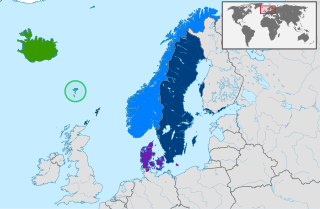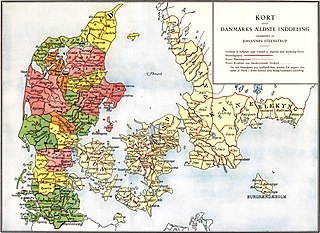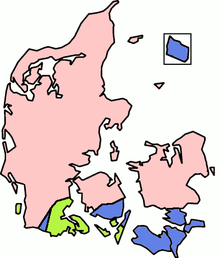
Danish is a North Germanic language spoken by about six million people, principally in and around Denmark. Communities of Danish speakers are also found in Greenland, the Faroe Islands, and the northern German region of Southern Schleswig, where it has minority language status. Minor Danish-speaking communities are also found in Norway, Sweden, the United States, Canada, Brazil, and Argentina.

Zealand at 7,031 km2 is the largest and most populous island in Denmark proper. Zealand had a population of 2,319,705 on 1 January 2020.

The North Germanic languages make up one of the three branches of the Germanic languages—a sub-family of the Indo-European languages—along with the West Germanic languages and the extinct East Germanic languages. The language group is also referred to as the Nordic languages, a direct translation of the most common term used among Danish, Faroese, Icelandic, Norwegian, and Swedish scholars and people.

The three lands of Denmark historically formed the Danish kingdom from its unification and consolidation in the 10th century:
A pitch-accent language is a type of language that, when spoken, has certain syllables in words or morphemes that are prominent, as indicated by a distinct contrasting pitch rather than by loudness or length, as in some other languages like English. Pitch-accent languages also contrast with fully tonal languages like Vietnamese, Thai and Standard Chinese, in which practically every syllable can have an independent tone. Some scholars have claimed that the term "pitch accent" is not coherently defined and that pitch-accent languages are just a sub-category of tonal languages in general.

Scanian is a Scandinavian speech variety spoken in the province of Scania in southern Sweden.

Shtokavian or Štokavian is the prestige supradialect of the pluricentric Serbo-Croatian language and the basis of its Serbian, Croatian, Bosnian and Montenegrin standards. It is a part of the South Slavic dialect continuum. Its name comes from the form for the interrogative pronoun for "what" što. This is in contrast to Kajkavian and Chakavian.
Jutlandic, or Jutish, is the western variety of Danish, spoken on the peninsula of Jutland in Denmark.
The sound system of Norwegian resembles that of Swedish. There is considerable variation among the dialects, and all pronunciations are considered by official policy to be equally correct – there is no official spoken standard, although it can be said that Eastern Norwegian Bokmål speech has an unofficial spoken standard, called Urban East Norwegian or Standard East Norwegian, loosely based on the speech of the literate classes of the Oslo area. This variant is the most common one taught to foreign students.
South Jutlandic or South Jutish is a dialect of the Danish language. South Jutlandic is spoken in Southern Jutland on both sides of the border between Denmark and Germany.
Stød is a suprasegmental unit of Danish phonology, which in its most common form is a kind of creaky voice (laryngealization), but it may also be realized as a glottal stop, especially in emphatic pronunciation. Some dialects of Southern Danish realize stød in a way that is more similar to the tonal word accents of Norwegian and Swedish. In much of Zealand it is regularly realized as reminiscent of a glottal stop. A probably unrelated glottal stop, with quite different distribution rules, occurs in Western Jutland and is known as the vestjysk stød. The word stød itself does not have a stød.

The Danish language developed during the Middle Ages out of Old East Norse, the common predecessor of Danish and Swedish. It was a late form of common Old Norse. The Danish philologist Johannes Brøndum-Nielsen divided the history of Danish into "Old Danish" from 800 AD to 1525 and "Modern Danish" from 1525 and onwards. He subdivided Old Danish into "Runic Danish" (800–1100), Early Middle Danish (1100–1350) and Late Middle Danish (1350–1525).
Bornholmsk is an East Danish dialect spoken on the island of Bornholm in the Baltic Sea. It was originally part of the East Danish dialect continuum, which includes the dialects of southern Sweden, but became isolated in the Danish dialect landscape after 1658, when Sweden annexed the eastern Danish provinces of Scania (Skåne), Halland and Blekinge.

Jutland is a peninsula of Northern Europe that forms the continental portion of Denmark and part of northern Germany.
The phonology of Danish is similar to that of the other closely related Scandinavian languages, Swedish and Norwegian, but it also has distinct features setting it apart. For example, Danish has a suprasegmental feature known as stød which is a kind of laryngeal phonation that is used phonemically. It also exhibits extensive lenition of plosives, which is noticeably more common than in the neighboring languages. Because of these and a few other features, spoken Danish can be challenging for Norwegians and Swedes to understand without training, although they can easily read written Danish.
Norrland dialects is one of the six major dialect groupings of the Swedish language. It comprises most dialects traditionally spoken in Norrland, except for those of Gästrikland and southern Hälsingland, which are usually classified as Svealand Swedish, as well as those of Härjedalen and northernmost Jämtland, which are usually classified as Norwegian.
Insular Danish are the traditional Danish dialects spoken on the islands of Zealand, Langeland, Funen, Falster, Lolland, and Møn. They are recorded in the Dictionary of Danish Insular Danish (Ømålsordbogen) which has been collected since the 1920s, and published in biannual volumes since 1992. There are significant differences between the different insular varieties, but they also share a number of features. A major difference is between Modern Danish and the traditional insular dialects are that some of them lack the stød but kept the tonal accent. Also, they kept three noun genders.
Niels Aage Anton Nielsen was a Danish professor of Nordic languages at Aarhus University. He was also a leader in the Danish resistance movement.

The Western Regional Command was the overall command of all Royal Danish Army units in Jutland and on Funen. It was split into four military regions, and was responsible for the regional defence. In 1990, the Regional Commands were disbanded and control was collected at the newly created Army Operational Command.











